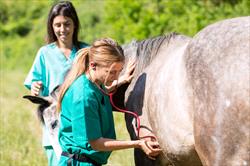prepurchase.jpeg

Getting a pre-purchase exam before buying a horse is a good idea, but there are many options for these exams. A pre-purchase exam can be anywhere from a thorough physical and lameness exam to multiple tests performed on the horse to determine its health.
A general pre-purchase exam usually involves checking all body systems physically and then performing a lameness exam by watching the horse walk and trot to check for lameness.
Your veterinarian will check for foot pain and perform flexion tests by flexing various joints to see if this affects the horse’s gait at a walk and a trot. Depending on your veterinarian and your requests, the horse you are considering buying may be ridden for the pre-purchase lameness exam. A pre-purchase evaluation does not include a positive or negative grade or whether the horse fails or passes the exam. The veterinarian’s job is to evaluate the horse medically and will probably not make any suggestions about whether you should or shouldn’t buy the horse.
Depending on the purchaser and the planned use of the horse, X-rays or radiographs are sometimes performed to gain further knowledge of the horse's condition. For example, horses used for barrel racing generally have different areas of concern than racehorses, so the veterinarian may have to X-ray different areas.
Some purchasers would like the upper airway examined with an endoscope, while others will request a reproductive exam if the horse will be used for breeding. If possible, the veterinarian may want to look at earlier medical records.
Realize that even with a pre-purchase exam, your veterinarian does not have a crystal ball to see the horse’s future and only has to consider how the horse looks on the day of the exam.